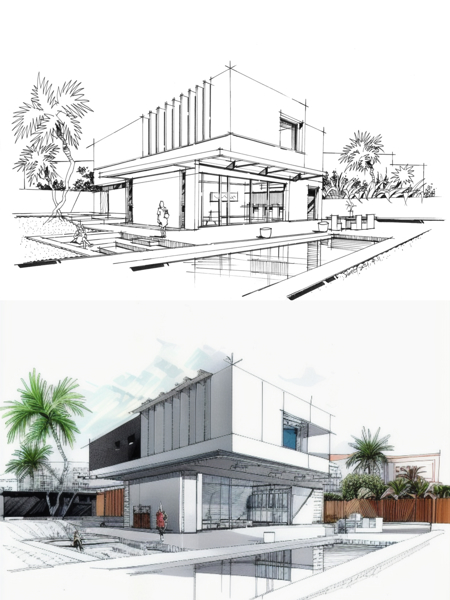Explore Acclaimed Projects by Renowned CDA Architects
Explore Acclaimed Projects by Renowned CDA Architects
Blog Article
An Extensive Introduction of Building Styles and Their Impact on Modern City Preparation and Advancement
Building designs have actually long worked as a mirror to the social values and technical innovations of their time, playing a vital function fit contemporary city preparation and advancement. From the majesty of Neoclassicism to the practical strategy of Brutalism, each style has actually presented special concepts that influence urban visual appeals and performance. As modern challenges develop, consisting of sustainability and area requirements, recognizing these historical structures comes to be necessary. The resulting dialogue not just informs future layout practices yet also raises relevant concerns about the equilibrium between heritage and development in our progressing metropolitan landscapes.
Historical Review of Architectural Designs

As cultures transitioned via the Center Ages, Gothic design emerged, defined by its verticality and elaborate detailing, mirroring the spiritual desires of the period. The Renaissance marked a revival of timeless perfects, merging art and design in cutting-edge ways that influenced succeeding styles across Europe.

Today, building styles remain to progress, driven by globalization and sustainability worries, showing a dynamic interaction between heritage and innovation. This historical introduction emphasizes the importance of design as a mirror of social development and as a stimulant for city advancement.
Key Architectural Styles Explained
The diversity of building styles mirrors the myriad impacts that form our developed atmosphere, each personifying unique attributes and social values. Secret building styles consist of Classic, Gothic, Baroque, Innovation, and Postmodernism, each representing unique historical contexts and aesthetic philosophies.
Classical style, rooted in ancient Greece and Rome, emphasizes balance, percentage, and making use of columns (cda architects). In comparison, Gothic design, growing between Ages, is identified by pointed arches, ribbed vaults, and flying buttresses, producing a spiritual quality in basilicas. Baroque design, arising in the 17th century, is marked by magnificence, fancy ornamentation, and a vibrant interaction of light and darkness
Modernism, which acquired momentum in the very early 20th century, prioritizes function over type, making use of brand-new products like steel and glass to create minimal structures. Postmodernism, reacting against the austerity of Modernism, welcomes eclecticism and historical referral, often including playful aspects and paradox.

Influence on Urban Preparation
In shaping the development of cities, architectural designs substantially influence urban planning decisions. The selection of architectural style usually dictates the visual appeals, performance, and total personality of city settings.
Moreover, architectural styles can impact zoning laws and land make use of plans. Urban organizers need to take into consideration the prevailing building their website trends when creating districts, making certain that new developments balance with existing structures. This consideration cultivates natural urban landscapes and enhances neighborhood identification.
The execution of details building styles can likewise influence socioeconomic variables within a city. Premium contemporary styles might bring in upscale residents and businesses, leading to gentrification, while much more budget-friendly real estate services may prioritize practical and lasting styles to fit diverse populaces. cda architects. Ultimately, the interaction in between architectural designs and city preparation produces vibrant cities that mirror both historic context and contemporary needs, shaping the lived experiences of their inhabitants
Sustainability and Modern Architecture
Building styles play a pivotal duty in addressing modern difficulties, especially weblink in the realm of sustainability. As city locations broaden and environmental issues heighten, modern architecture progressively welcomes sustainable layout principles that prioritize power effectiveness, source conservation, and very little ecological effect.
Contemporary building activities, such as biophilic layout and environment-friendly style, supporter for structures that harmonize with their environments, utilizing all-natural materials and advertising biodiversity. These styles usually integrate renewable resource sources, such as solar panels and wind generators, to reduce reliance on nonrenewable fuel sources and lower carbon footprints.
In addition, the assimilation of advanced technologies, such as wise building systems, improves power monitoring, enhancing source use while making certain resident convenience. Innovative water management methods, including rain harvesting and greywater recycling, more add to lasting city environments.
Especially, sustainability extends beyond environmental problems; it encompasses social and economic dimensions. By promoting neighborhood well-being and advertising inclusivity, modern building designs align with lasting development goals. Subsequently, the development of building practices remains to shape resilient cities that not just fulfill the demands of today yet additionally protect the future for generations ahead.
Neighborhood Engagement in Style
Neighborhood interaction in layout functions as an important bridge official website in between engineers and the populaces they offer, making certain that the constructed environment mirrors the needs and ambitions of its users. This collective procedure invites neighborhood participants to add their insights and choices, cultivating a sense of ownership and responsibility towards the areas they populate.
Effective neighborhood involvement employs numerous techniques, such as workshops, studies, and public discussion forums, to gather varied viewpoints. These techniques help with a two-way discussion, allowing architects to comprehend neighborhood contexts while encouraging homeowners to voice their issues and wishes. This inclusivity not just boosts the design high quality however additionally advertises social equity by resolving the one-of-a-kind obstacles faced by marginalized groups.
Furthermore, community involvement can bring about cutting-edge solutions that may not arise in a standard design process. By incorporating neighborhood knowledge and cultural values, engineers can create spaces that reverberate even more deeply with customers, enhancing use and sustainability. Inevitably, prioritizing area interaction in style procedures causes atmospheres that nurture social communications, support health, and strengthen neighborhood connections, thus playing an essential duty in shaping modern-day metropolitan landscapes.
Final Thought
Building designs have actually exceptionally affected modern city preparation and growth, showing progressing social and technical contexts. The integration of historic aesthetics with modern requirements fosters city atmospheres that focus on sustainability and area engagement. As cities continue to grow and adjust, the recurring dialogue in between architectural heritage and contemporary layout principles will certainly continue to be crucial in producing inclusive, vibrant areas that enhance top quality of life and promote social equity. The future of metropolitan development hinges on this harmonious equilibrium.
Report this page